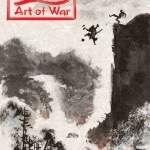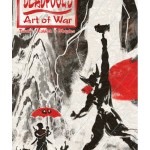Even Chinese philosopher/strategists from the 6th century BC can become the target of a modern-day super assassin, and Deadpool isn’t about to let a 2500-year distance keep him from fulfilling a contract. After taking out Sun Tzu (and don’t expect an explanation about the whole time-travel issue, because you aren’t getting one), Deadpool stumbles across the military tactician’s masterpiece, The Art of War, and the dollar signs light up in his eyes. Here is a sure-fire ticket to fame, wealth, and the admiration of the world. But how to display a dazzling skill for war strategy on a global level when there isn’t a global war going on? That’s easy: you start one.
What follows is a continuity-free trek through the Marvel universe as Daredevil eggs on Loki to attack both Asgard and then Midgard, eventually dragging every recognizable superhero into the fray, all while keeping his eyes on the one prize that would be worth all of this destruction: a publishing deal.
Peter David has been a favorite author of mine ever since I first read his Star Trek books (Q in Law should be required reading for any ST:TNG fan. Q-Squared would be for the advanced class.) David has an amazing talent for writing in the perfect “voice” for established characters; he displays this to great effect when writing the good-natured but easily irritated psychopath that is Deadpool. He also usually includes in his writing a healthy dose of the ridiculous, something which comes in handy for this story.
Deadpool quickly decides neither the Young Loki nor Lady Loki will suit his purposes (giving a shout-out to authors Matt Fraction and Straczynski, and also an agonized scream of “I can’t operate under these conditions!”), and selects the Silver-Age Loki in all his scenery-chewing glory. Deadpool gets Loki to follow his suggestions for strategy in attacking Asguard, capturing Thor, and convincing Odin to surrender his kingdom in order to save his son.
From there it’s an easy matter to convince Loki to really hurt Thor by taking his army to invade Earth, thereby giving Deadpool the opportunity to stage some some real-world demonstrations of wisdom from the definitive work of military strategy. His whole plan to secure a book contract is going swimmingly…
…until Loki does exactly what everyone should have known he’d do, and throws the mentally unstable mercenary into the dungeon so he can finish his war on Midgard in peace. Oh, it’s on now.
Don’t expect a serious work here; as is usual for a Deadpool story, the characters throw in meta-references to the book, have the most two-dimensional motivations imaginable, and break the fourth wall repeatedly. It’s a hell of a lot of fun. Deadpool has a running “Who’s On First” gag based on Asgardian dialect, and everyone takes turns reacting to the narration.
Fans of the Avengers movie especially will love the Hulk scenes, but everyone who’s ever enjoyed a Marvel title will have something to like, since the artwork of this comic could be used as a “name the hero” game, with just about every panel containing a different collection of Marvel characters.
Speaking of artwork, Scott Koblish was the perfect choice for this graphic novel. An experienced alum from the Kubert school, Kubish has worked on dozens of Marvel titles, including past issues of Deadpool. His crisp, cartoony-yet-intricate style – combined with Val Staples’s antique colors- works equally well in action scenes and in the opening of the story set in ancient China. Koblish also likes to slip the occasional in-joke into his artwork; look for a reference to Milo Manara’s Spider-Woman controversy.
Peter David sticks to The Art of War theme throughout, having the action follow along with selected passages from the book. In the end Deadpool does get his book deal (sort of), but it’s doubtful that he’s actually learned anything. Sun Tzu himself wrote that war was a necessary evil that must be avoided whenever possible; not even a severe beating by all of the Avengers is likely to convince Deadpool of that.
One last note about the artwork: I would REALLY love to have the cover art for each of the four issues framed and hung on my wall. Koblish did them in the style of Chinese brushwork, and they’re gorgeous. And the one I used for the banner makes me laugh every time I look at it.





